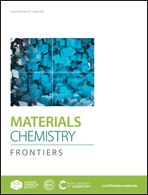Binder-free 3D SnO2-based nanocomposite anode with high areal capacity for advanced sodium-ion batteries†
Abstract
Nanostructured SnO2-based electrode materials and their composites have shown extraordinary promise for sodium-ion batteries (SIBs), but these are usually limited to laboratory cells with a low areal capacity because of the rather low mass loading. We report three-dimensional (3D) ultrathin SnO2 nanosheet/holey graphene composite frameworks (SnO2 NS/HGFs) with a high mass loading of 9 mg cm−2 that can deliver a high areal capacity of up to 2.5 mA h cm−2 under a current density of 0.9 mA cm−2 and a stable areal capacity of 1.5 mA h cm−2 under a high current density of 9 mA cm−2. The superior performance of the 3D SnO2-based nanocomposite anode was realized by implanting ultrathin SnO2 NS/graphene composites into 3D HGF, and the sluggish Na+ transport, poor conductivity and volume expansion problems of SnO2 were well addressed by encapsulating ultrathin SnO2 nanosheets into densely packed graphene sheets, where the highly interconnected 3D holey graphene network facilitates rapid charge and ion transport. This work represents a critical step forward toward practical SIBs applications of SnO2-based electrode materials with high capacity.



 Please wait while we load your content...
Please wait while we load your content...